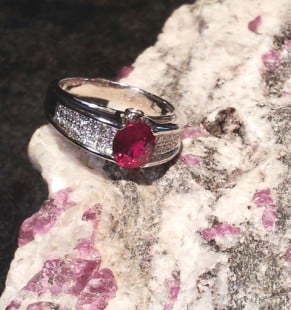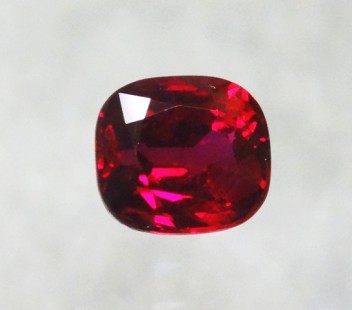
Ruby ring on ruby-bearing gneiss
The moniker “The King of Gemstones” sounds pretty impressive, doesn’t it? Do you think it belongs to diamond? It doesn’t; ruby got that name when diamonds were still largely unmined and unusable as gemstones because the technology did not exist to fashion them. The phrase actually comes from the Sanskrit word for ruby: ratnaraj. Anything associated with fire, passion, healthy, love, anger, or the like has been attributed to rubies for millennia, starting in Ancient India, which was considered the classical source of rubies until the distribution of Burmese material. However, Stone and Bronze Age mining tools have been discovered around the Mogok ruby mine in Myanmar, indicating that the rubies have been known and mined there since before written records.
Today, fine natural rubies over ten carats represent the most expensive gemstones in the world. Even diamonds can’t touch them. But does that mean all rubies are outrageously expensive? Not at all. It is true that the best rubies usually command prices similar to fine diamonds, but you’re not likely to encounter the best rubies just anywhere. Like all gemstones, there are other grades of ruby besides “the best,” which are still beautiful and affordable. As the birthstone for July, ruby can’t be totally exclusive. Where’s the fun in that?
The ruby for you may be the richest red you can find, and in that situation, you should expect to pay a premium for your ruby. But maybe you prefer a softer red leaning more to the pink side, in which case, you’ll probably find a bargain. It all depends on your tastes. Always be sure to view rubies on a solid black or solid white background to get a realistic idea of the coloration of the stones you are shopping. It is a sneaky practice in some places to present rubies on a brass or bronze plate, which can mask any impurities in the red hue, especially brown and orange undertones.
When shopping for ruby, top quality material is certified natural, untreated, and vibrant medium to medium-dark red with a slightly bluish undertone. Many rubies have orange or brown modifying tones, while others are more pink than red (more on that in another blog).
There are several notable ruby mines in the world, with Mogok in Burma still leading the pack after decades. Luc Yen, Vietnam, was a strong producer in the 1990s, and Winza, Tanzania, put out some amazing stones after the turn of the 21st Century. The new powerhouse is the Montepuez area of Mozambique. Extraordinary gems that rival the finest Burmese material in every way are still coming out of East Africa.
But each mine has produced its own top quality gems, so origin doesn’t automatically translate to quality. Burma produces commercial grade rubies just like Kenya does. As a savvy consumer, always look for quality of physical characteristics before you let any biases about provenance color your view of the quality of a stone.

Cushion cut ruby
Some common treatments that may affect the price and durability of a ruby of which to be aware are heating and fracture-filling. Heating to improve both color and clarity is ubiquitous and basically an accepted treatment to ruby because it is permanent and stable. It is usually done to the rough right at the mine, so obtaining certified untreated ruby will cost you.
Fracture-filling is much less stable. Gems that have surface-reaching cracks are filled with anything from glass to epoxy resins to reduce the relief of the internal fractures of a stone, which improves clarity, much like oiling an emerald. However, fracture-filling cannot be safely redone to rubies if the filling material leeches out of the stone. Fracture-filled rubies are common in commercial grade, and less so in medium grade, but a ruby classified as “fine grade” should never have fracture-filling. Heat or pressure (steam cleaning, a jeweler’s torch, ultrasonic cleaning) applied to a fracture-filled ruby can cause it to shatter. Not good.
I keep only a small selection of rubies on hand to whet the appetite, but I have ready access to rubies ranging from the beautifully economic to the truly magnificent. If you’re inclined towards a ruby purchase, I hope you’ll stop in, check out some rubies, and get some education. And remember: red is always in season.
Tags: Ancient India, burma, clarity, diamonds, gemstones, July Birthstone, Kenya, rubies, ruby